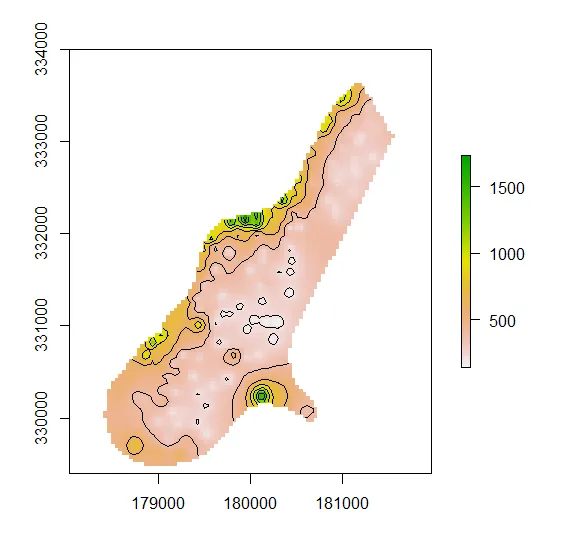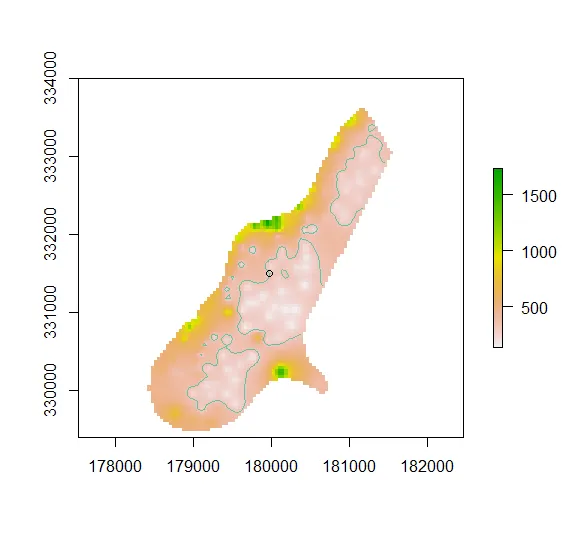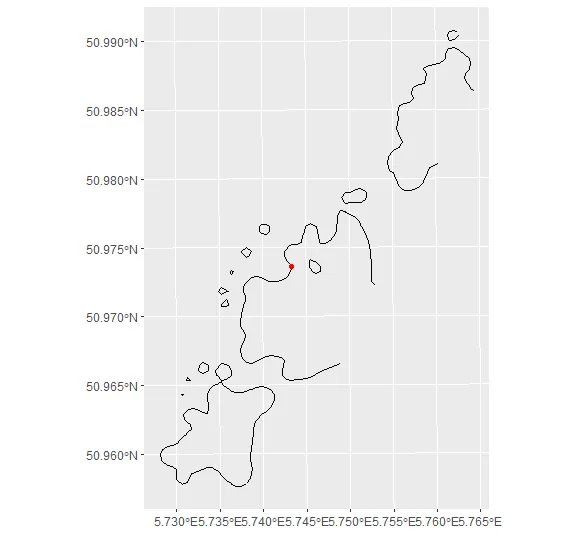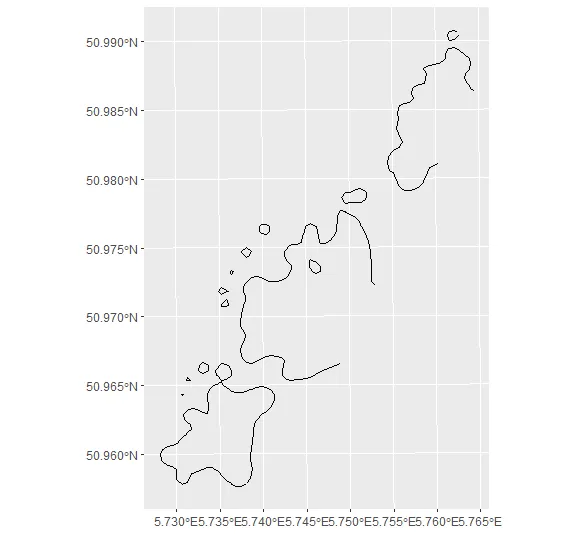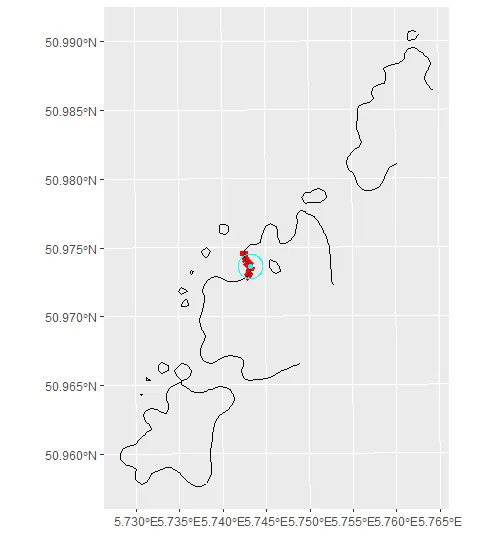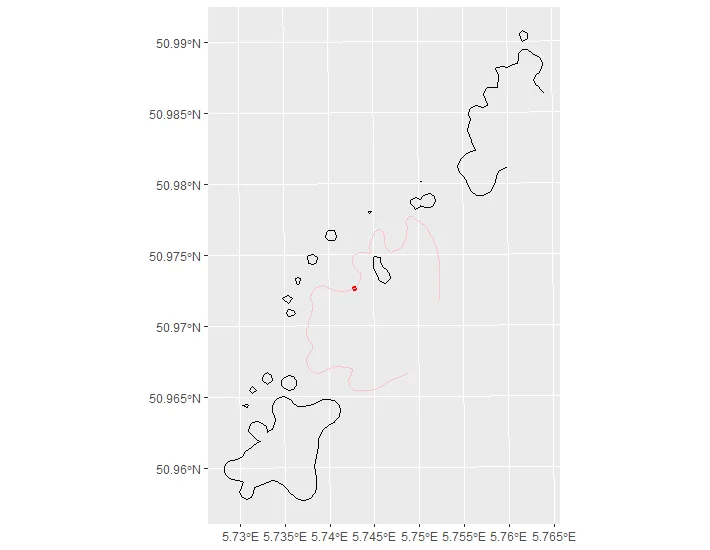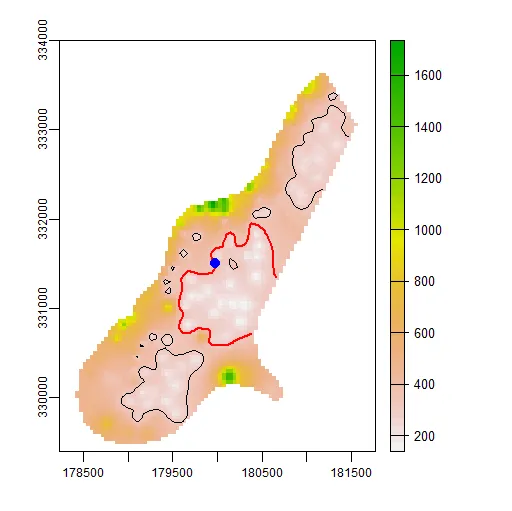我正在尝试使用R中的
所以,我已经使用
raster包从栅格对象中提取等高线。
rasterToContour似乎工作得很好,并且绘制得很漂亮,但是当进行调查时,发现等高线被分成了不规则的段。来自?rasterToContour的示例数据。library(raster)
f <- system.file("external/test.grd", package="raster")
r <- raster(f)
x <- rasterToContour(r)
class(x)
plot(r)
plot(x, add=TRUE)
rasterToContour(),指定轮廓线level的高程。# our sample site - a random cell chosen on the raster
xyFromCell(r, 5000) %>%
SpatialPoints(proj4string = crs(r)) %>%
{. ->> site_sp} %>%
st_as_sf %>%
{. ->> site_sf}
# find elevation of sample site, and extract contour lines
extract(r, site_sf) %>%
{. ->> site_elevation}
# extract contour lines
r %>%
rasterToContour(levels = site_elevation) %>%
{. ->> contours_sp} %>%
st_as_sf %>%
{. ->> contours_sf}
# plot the site and new contour lines (approx elevation 326)
plot(r)
plot(contours_sf, add = TRUE)
plot(site_sf, add = TRUE)
# plot the contour lines and sample site - using sf and ggplot
ggplot()+
geom_sf(data = contours_sf)+
geom_sf(data = site_sf, color = 'red')
st_intersects函数来查找与站点相交的线(缓冲宽度为100以确保它与线接触)。但是,这会返回所有等高线。contours_sf %>%
filter(
st_intersects(., site_sf %>% st_buffer(100), sparse = FALSE)[1,]
) %>%
ggplot()+
geom_sf()
我认为所有的行都被返回了,因为它们似乎是一个单独的MULTILINESTRINGsf对象。
contours_sf
# Simple feature collection with 1 feature and 1 field
# geometry type: MULTILINESTRING
# dimension: XY
# bbox: xmin: 178923.1 ymin: 329720 xmax: 181460 ymax: 333412.3
# CRS: +proj=sterea +lat_0=52.1561605555556 +lon_0=5.38763888888889 +k=0.9999079 +x_0=155000 +y_0=463000 +datum=WGS84 +units=m +no_defs
# level geometry
# C_1 326.849822998047 MULTILINESTRING ((179619.3 ...
所以,我已经使用
ngeo::st_segments()将contours_sfMULTILINESTRING拆分成单独的线条(我找不到任何sf方法来做到这一点,但如果这是问题,我可以使用替代方法,特别是如果这是问题)。出乎意料的是,这返回了394个要素;从图中看,我预计大约有15条分离的线条。contours_sf %>%
nngeo::st_segments()
# Simple feature collection with 394 features and 1 field
# geometry type: LINESTRING
# dimension: XY
# bbox: xmin: 178923.1 ymin: 329720 xmax: 181460 ymax: 333412.3
# CRS: +proj=sterea +lat_0=52.1561605555556 +lon_0=5.38763888888889 +k=0.9999079 +x_0=155000 +y_0=463000 +datum=WGS84 +units=m +no_defs
# First 10 features:
# level result
# 1 326.849822998047 LINESTRING (179619.3 329739...
# 2 326.849822998047 LINESTRING (179580 329720.4...
# 3 326.849822998047 LINESTRING (179540 329720, ...
# 4 326.849822998047 LINESTRING (179500 329735.8...
# 5 326.849822998047 LINESTRING (179495.3 329740...
# 6 326.849822998047 LINESTRING (179460 329764, ...
# 7 326.849822998047 LINESTRING (179442.6 329780...
# 8 326.849822998047 LINESTRING (179420 329810, ...
# 9 326.849822998047 LINESTRING (179410.2 329820...
# 10 326.849822998047 LINESTRING (179380 329847.3...
然后,当我们过滤以保留与站点相交的线(缓冲区宽度为100)时,只返回了预期等高线的一小部分(红色线段,我认为反映了100缓冲区宽度)。
contours_sf %>%
nngeo::st_segments() %>%
filter(
# this syntax used as recommended by this answer https://dev59.com/vLXna4cB1Zd3GeqPEhEJ#57025700
st_intersects(., site_sf %>% st_buffer(100), sparse = FALSE)
) %>%
ggplot()+
geom_sf(colour = 'red', size = 3)+
geom_sf(data = contours_sf)+
geom_sf(data = site_sf, colour = 'cyan')+
geom_sf(data = site_sf %>% st_buffer(100), colour = 'cyan', fill = NA)
有人对以下几点有想法吗:
- 解释为什么等高线是“断裂的”
- 提供一种有效的方法来“连接”这些断裂的部分
- 如果
nngeo::st_segments()确实是 394 条线而不是 ~15 条线的来源,那么可以考虑另一种方法
